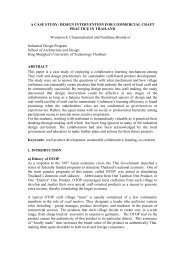soa+d research manual - School of Architecture and Design, KMUTT
soa+d research manual - School of Architecture and Design, KMUTT
soa+d research manual - School of Architecture and Design, KMUTT
Create successful ePaper yourself
Turn your PDF publications into a flip-book with our unique Google optimized e-Paper software.
2<br />
REVIEWING THE LITERATURE<br />
INTRODUCTION<br />
The literature review is an essential component <strong>of</strong> every<br />
<strong>research</strong> project. like many aspects <strong>of</strong> <strong>research</strong> inquiry it<br />
differs in its role, purpose <strong>and</strong> even position within the <strong>research</strong><br />
process. in the conventional investigation, for example, the<br />
review occurs before the design <strong>of</strong> the methodology (<strong>and</strong> indeed,<br />
plays an important role in the <strong>research</strong> design). in grounded<br />
theory, it is prohibited to carry out a preliminary literature review<br />
as this might interfere with a more direct <strong>and</strong> unmediated<br />
encounter with the <strong>research</strong> subject. in some conventional<br />
<strong>research</strong>, the review is limited to published <strong>research</strong> on the<br />
topic <strong>of</strong> inquiry. in practice-based <strong>research</strong>, the review includes<br />
examples <strong>of</strong> semiotic <strong>and</strong> material culture as well as a broader<br />
range <strong>of</strong> theoretical texts.<br />
Nevertheless, every <strong>research</strong> project will involve a ‘literature’<br />
review <strong>of</strong> an appropriate kind <strong>and</strong> in this note i will <strong>of</strong>fer a brief<br />
overview <strong>of</strong> this important aspect <strong>of</strong> <strong>research</strong> inquiry. my method<br />
here will be a little different from other Research Notes in that<br />
i will mainly use the words <strong>of</strong> another. That is, quotations <strong>and</strong><br />
paraphrases from the excellent book Doing a literature Review<br />
by chris hart (2000).<br />
WHAT IS A LITERATURE REVIEW?<br />
The literature review is integral to the success <strong>of</strong> your academic<br />
<strong>research</strong> project. but what is it? Put simply it:<br />
is the selection <strong>of</strong> available documents on the topic [...] <strong>and</strong> the<br />
effective evaluation <strong>of</strong> these in relation to the <strong>research</strong> being<br />
proposed.<br />
The overall purpose <strong>of</strong> the review is:<br />
to show comm<strong>and</strong> <strong>of</strong> the subject area; underst<strong>and</strong>ing<br />
<strong>of</strong> the problem; to justify the <strong>research</strong> topic, design <strong>and</strong><br />
methodology.<br />
more specifically the review serves two essential functions:<br />
<strong>research</strong>ability <strong>and</strong> scoping:<br />
A major benefit [...] is that it ensures the <strong>research</strong>ability <strong>of</strong><br />
the topic before ‘proper’ <strong>research</strong> commences [...] it is the<br />
progressive narrowing <strong>of</strong> the topic through the literature<br />
review that makes most <strong>research</strong> a practical proposal.<br />
According to hart, this is no easy or quick matter:<br />
Narrowing down a topic can be difficult <strong>and</strong> can take several<br />
weeks or even months [...] time <strong>and</strong> effort carefully expended<br />
at this stage can save a great deal <strong>of</strong> effort <strong>and</strong> vague<br />
searching later.<br />
hart also outlines a useful summary <strong>of</strong> the review:<br />
REsEARch NOTEs<br />
21<br />
We can say that the review serves at least the following<br />
purposes in <strong>research</strong>:<br />
1 distinguishing what has been done from what<br />
needs to be done;<br />
2 discovering important variables relevant to<br />
the topic;<br />
3 synthesising <strong>and</strong> gaining a new perspective;<br />
4 identifying relationships between ideas <strong>and</strong><br />
practice;<br />
5 establishing the context <strong>of</strong> the problem;<br />
6 rationalising the significance <strong>of</strong> the problem;<br />
7 enhancing <strong>and</strong> acquiring the subject vocabulary;<br />
8 underst<strong>and</strong>ing the structure <strong>of</strong> the subject;<br />
9 identifying the main methodologies <strong>and</strong> techniques that<br />
have been used;<br />
10 placing the <strong>research</strong> in a historical context <strong>and</strong> showing<br />
familiarity with state-<strong>of</strong>-the-art developments.<br />
GETTING STARTED<br />
The starting point for any review is topic definition. This is an<br />
important step <strong>and</strong> should not be skipped because <strong>of</strong> knowledge<br />
you may think you already have <strong>of</strong> the field:<br />
start with some general reading to familiarize yourself<br />
with the topic. consult subject specific dictionaries <strong>and</strong><br />
encyclopaedias. Take notes on the concepts used <strong>and</strong> which<br />
authors are cited. Prepare a list <strong>of</strong> terms for further searching.<br />
begin to think about the shape <strong>of</strong> the topic so that you can<br />
map it out at a later stage.<br />
Once you have established an overview, it is time to scope the<br />
review:<br />
Ask questions about which language or languages it might be<br />
necessary to search” what time frame i.e. how far back you<br />
might need to search; what subject areas might be relevant.



